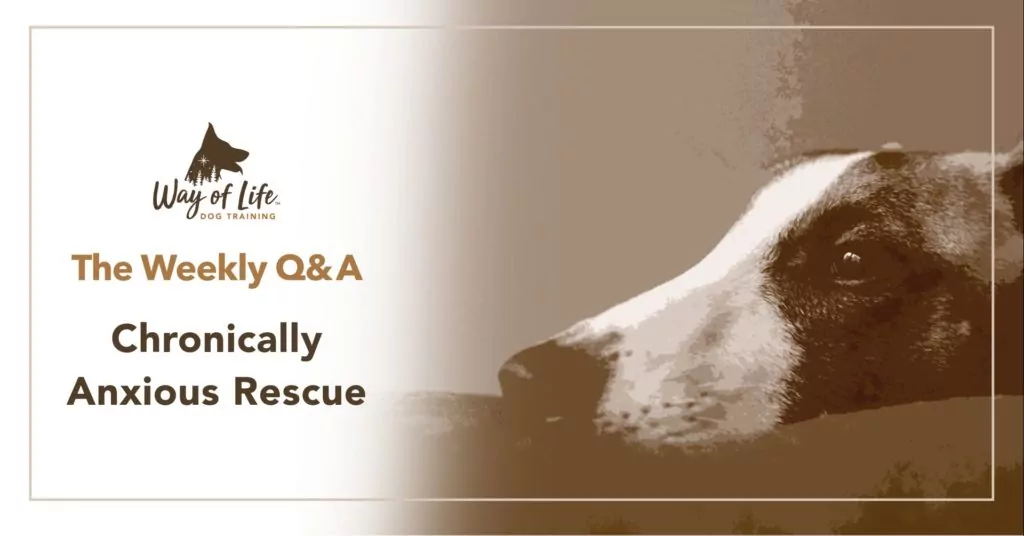
Q: I have a 7-year-old Collie-Whippet rescue who’s dealing with chronic anxiety that is affecting his quality of life. He spends most of his time hiding from sounds and I’ve noticed things getting worse over the last 6 months (now turning into separation anxiety). His anxiety is due to environmental sounds (traffic, sirens, wind, car doors, etc.) and he spends most of his day hidden away. My partner and I have tried a lot and had some successes but really, we’re concerned about what he’ll be like in 6-12 months given the direction he’s headed in. I’m really interested to hear about your experience with such phobias and would be thrilled to hear about your approach.
A: There’s no question that chronic anxiety and phobias undermine a dog’s quality of life. I commend you and your partner for trying different things and contacting a professional. Know that you’re not alone, as I am often contacted about dogs so fearful that simply existing is difficult for them.
The first shift I’d ask you to make is to understand that the sound phobias, anxiety, and separation anxiety you’re seeing are not necessarily inherent in the dog. Try to internalize the idea that “anxious” and “fearful” are not what the dog is, but how he knows how to deal with his way of life.
I appreciate that you’ve probably looked high and low for a solution to this challenge, but the information available in the mainstream dog training world is limited because it views the behavior for what it is, tries to modify it, while overlooking root cause. I focus on way of life and the relationship it produced. In my view, how we see our dogs is at the heart of our relationships with them. And as we see them, so shall they be.
The second shift I’d ask you to make is in the way of life you embrace with your dog. I sense from your note that your dog has been allowed to act on his fears by choosing to spend most of his time hidden. He has been validated in his choices and in the fear driving these choices. In effect, he has been given permission to be fearful and thus fearful he has become. He might have started out a little withdrawn and unsure, but with our permission – simply by us thinking the fears legitimate and letting the dog be fearful – the tendency has now been intensified.
At Way of Life™, the right to make decisions is granted to dogs only after they have gone through the correct rearing and relationship stages. We raise them to become sound dogs that aren’t afraid of things, can be trusted with some decisions, and are worthy of a measure of freedom. Scared and phobic dogs cannot be given such privileges. Fearful dogs don’t get to make decisions; rather, they need us to take charge because they clearly aren’t fit to do so. When we fail to guide a fearful dog, we risk leaving them in a deeper pit of despair.
When working with extremely fearful and anxious dogs, we take things back to a simple and structured state. The idea is to avoid eliciting a fear response in the dog, so that fear is no longer the response. We take charge of the dog by deciding when and where the dog will be in their designated “hiding place” – i.e., scheduled time in a crate. We schedule designated outings that start off as short at this point, given the dog’s extreme state of fear. If the dog is comfortable in the yard, that’s where we’re staying for a while. If the dog is okay in the building’s vicinity, that’s where we’re spending time together.
We take charge, we start small, and we build on that. We go back to square one and rebuild the relationship, this time on healthy foundations where we’re the ones managing the dog instead of letting the dog manage itself. Doing things in a structured and successful way, with our patient leadership, will restore the dog to a minimum self-esteem and then we expand on that foundation.
Therefore, we don’t work to eradicate fears, anxieties, or worries in dogs. We know that these can exist in the soundest of dogs. But there is a difference between mild annoyances and extreme anxieties, and it’s our way of life, in all its psychological and practical aspects, that makes the difference. I hope you see the power of this change in perspective.